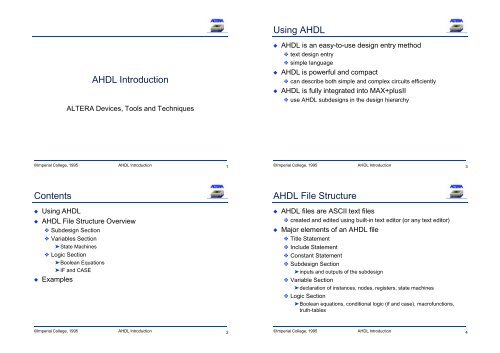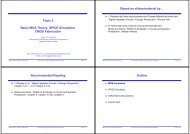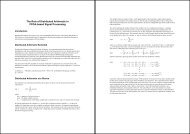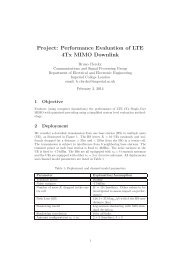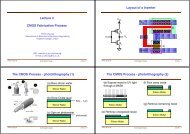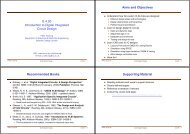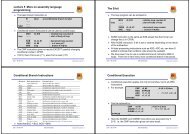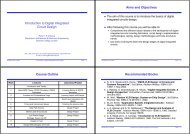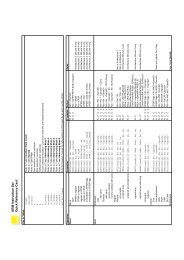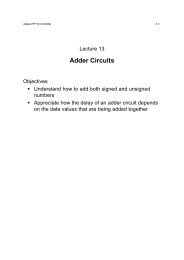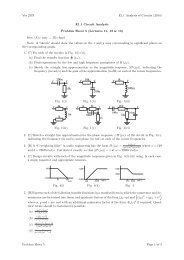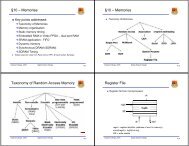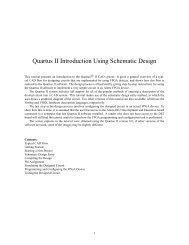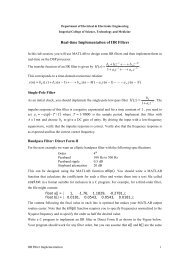AHDL Introduction Contents Using AHDL AHDL File Structure
AHDL Introduction Contents Using AHDL AHDL File Structure
AHDL Introduction Contents Using AHDL AHDL File Structure
Create successful ePaper yourself
Turn your PDF publications into a flip-book with our unique Google optimized e-Paper software.
<strong>Using</strong> <strong>AHDL</strong><strong>AHDL</strong> <strong>Introduction</strong>ALTERA Devices, Tools and Techniques◆ <strong>AHDL</strong> is an easy-to-use design entry method❖ text design entry❖ simple language◆ <strong>AHDL</strong> is powerful and compact❖ can describe both simple and complex circuits efficiently◆ <strong>AHDL</strong> is fully integrated into MAX+plusII❖ use <strong>AHDL</strong> subdesigns in the design hierarchy©Imperial College, 1995 <strong>AHDL</strong> <strong>Introduction</strong> 1©Imperial College, 1995 <strong>AHDL</strong> <strong>Introduction</strong> 3<strong>Contents</strong>◆ <strong>Using</strong> <strong>AHDL</strong>◆ <strong>AHDL</strong> <strong>File</strong> <strong>Structure</strong> Overview❖ Subdesign Section❖ Variables Section➤State Machines❖ Logic Section➤Boolean Equations➤IF and CASE◆ Examples<strong>AHDL</strong> <strong>File</strong> <strong>Structure</strong>◆ <strong>AHDL</strong> files are ASCII text files❖ created and edited using built-in text editor (or any text editor)◆ Major elements of an <strong>AHDL</strong> file❖ Title Statement❖ Include Statement❖ Constant Statement❖ Subdesign Section➤inputs and outputs of the subdesign❖ Variable Section➤declaration of instances, nodes, registers, state machines❖ Logic Section➤Boolean equations, conditional logic (if and case), macrofunctions,truth-tables©Imperial College, 1995 <strong>AHDL</strong> <strong>Introduction</strong> 2©Imperial College, 1995 <strong>AHDL</strong> <strong>Introduction</strong> 4
Subdesign SectionVariables Section - State Machines◆ specifies the interface between this subdesign and othermodules in the design◆ INPUTs and OUTPUTs are named❖ names have scope limited to a subdesign◆ groups can be referred to using the syntax :❖ E.g. x[3..0] represents x3, x2, x1, x0◆ examples:SUBDESIGN divide2(x: INPUT;div2 : OUTPUT;)SUBDESIGN top(clk1, clk2 : INPUT;a0, a1, a2 : OUTPUT;b[7..0] : BIDIR;)◆◆◆state machines are created inthe Variables Sectionname of the machinekeywords❖ MACHINE➤ specifies a state machine❖ OF BITS➤ optional➤ names the output bits of themachine (register outputs)❖ WITH STATES➤ comma separated list of states➤ optional numerical value of theoutput bits for each state➤ first state in list is reset stateVARIABLErow_seq: MACHINEOF BITS (row[4..1])WITH STATES (r0 = 0,r1 = 1,r2 = 2,r3 = 4,r4 = 8);©Imperial College, 1995 <strong>AHDL</strong> <strong>Introduction</strong> 5©Imperial College, 1995 <strong>AHDL</strong> <strong>Introduction</strong> 7Variables SectionLogic Section - Boolean Equations◆◆declares the variables used inthe Logic Sectiontypes of variables❖ instances➤ declares an instance of aprimitive or macrofunction◆ buffers, flip-flops, I/Os andgates◆ use . (dot) syntax to refer to aport of a primitive in LogicSection❖ nodes➤ declares an intermediate node(not an input or output)This syntax describes a “group” :-key[3..0] means key3, key2, key1, key0.VARIABLEff : DFFBEGINff.clk = x;ENDVARIABLEkey[3..0]: NODE;◆◆◆◆◆Logic section follows theVariables Sectionenclosed by BEGIN and ENDmain operators❖ ! NOT❖ & AND❖ # OR❖ $ XOR❖ !&, !#, !$ NAND, NOR, XNOR❖ - negateBoolean expressions caninvolve groupsconstants can be used❖ B"1100" is a binary constantBEGINs = a $ b;c = a & b;p = ((a & b) # c # (!a & !b &!c));END;a[3..0] = b[3..0] & c[3..0];means : a3 = b3 & c3, a2 = b2 & c2,a1 = b1 & c1, a0 = b0 & c0x[4..1] = y[2..1];means : x4 = y2, x3 = y1,x2 = y2, x1 = y1©Imperial College, 1995 <strong>AHDL</strong> <strong>Introduction</strong> 6©Imperial College, 1995 <strong>AHDL</strong> <strong>Introduction</strong> 8
Logic Section - IF and CASEExamples◆◆IF statement❖ used for conditional logic basedon comparisons➤ ==, !=, >, =, out[] = B”00”;WHEN 1 => out[] = B”01”;WHEN 2 => out[] = B”11”;WHEN 3 => out[] = B”10”;END CASE;◆ Combinational ◆ Sequential% Half adder to add %% together a and b %% giving sum s and %% carry c. %TITLE “Full Adder”SUBDESIGN myadder(a,b: INPUT;s,c: OUTPUT;)BEGINs = a $ b;c = a & b;END;% Frequency division by %% 2. Note the use of the %% GLOBAL clock. %TITLE “Divide by 2”SUBDESIGN divide2(x: INPUT;div2: OUPUT;)VARIABLEff: DFF;BEGINff.clk = GLOBAL(x);ff.d = !ff.q;div2 = ff.q;END;©Imperial College, 1995 <strong>AHDL</strong> <strong>Introduction</strong> 9©Imperial College, 1995 <strong>AHDL</strong> <strong>Introduction</strong> 11Logic Section - Truth TablesExamples◆◆combinational logic can beentered as a truth table❖ keywords:➤ TABLE and END TABLE❖ inputs on left of =>❖ outputs on right of =>legal entries in a truth table❖ nodes❖ groups❖ VCC and GND❖ X (don’t care)❖ constantsTABLEa,b=> sum,carry,gray[1..0];0,0 => 0, 0, B”00”;0,1 => 1, 0, B”01”;1,0 => 1, 0, B”01”;1,1 => 0, 1, B”11”;END TABLE;◆State MachineTITLE "Keyboard Scanning State Machine";SUBDESIGN kbd_scan(row_en, clock38, key[1..0] : INPUT;row[4..1]: OUTPUT;)VARIABLErow_seq: MACHINEOF BITS (row[4..1])WITH STATES (r0 = 0,r1 = 1,r2 = 2,r3 = 4,r4 = 8);(contd ...)BEGINrow_seq.clk = clock38;row_seq.ena = row_en;CASE row_seq ISWHEN r1 =>IF key[] == 0 THEN row_seq = r2;ELSE row_seq = r4;END IF;WHEN r2 =>IF key[] == 0 THEN row_seq = r3;ELSE row_seq = r1;END IF;WHEN r3 =>IF key[] == 0 THEN row_seq = r4;ELSE row_seq = r2;END IF;WHEN r4 =>IF key[] == 0 THEN row_seq = r1;ELSE row_seq = r3;END IF;WHEN OTHERS => row_seq = r1;END CASE;END;©Imperial College, 1995 <strong>AHDL</strong> <strong>Introduction</strong> 10©Imperial College, 1995 <strong>AHDL</strong> <strong>Introduction</strong> 12


